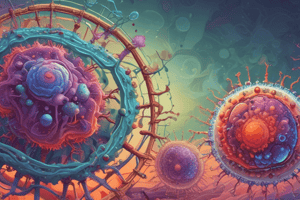Podcast
Questions and Answers
What is the basic structure of a virus?
What is the basic structure of a virus?
A virus consists of nucleic acid surrounded by a protein coat.
Why are viruses considered obligate parasites?
Why are viruses considered obligate parasites?
Viruses must live in or on a host organism to survive, causing harm to the host.
Explain the significance of receptor sites in viral infection.
Explain the significance of receptor sites in viral infection.
Receptor sites on the host cell determine the specificity of a virus for that cell type.
What happens during the synthesis stage of viral replication?
What happens during the synthesis stage of viral replication?
How do vaccines prevent viral diseases?
How do vaccines prevent viral diseases?
What role do bacteriophages play in controlling bacterial infections?
What role do bacteriophages play in controlling bacterial infections?
Identify one viral disease that affects humans and one that affects plants.
Identify one viral disease that affects humans and one that affects plants.
What happens to the host cell during the release stage of viral replication?
What happens to the host cell during the release stage of viral replication?
Flashcards are hidden until you start studying
Study Notes
Virus Structure and Characteristics
- Viruses are tiny microorganisms consisting of nucleic acid (DNA or RNA) surrounded by a protein coat (capsid).
- Viruses can be rod-shaped, spherical, or complex in shape.
- Viruses are obligate parasites, meaning they must live in or on a host organism to survive and reproduce.
- Viruses are not included in the Five Kingdom system because they are non-cellular and cannot carry out metabolic reactions independently.
Virus Replication Cycle
- Attachment: Viruses attach to host cells through specific interactions between proteins on the virus and receptor sites on the host cell membrane.
- Entry: Viruses penetrate the host cell and release their nucleic acid.
- In animal cells, the viral protein coat may also enter the cell but is then digested.
- Synthesis: The viral nucleic acid takes over the host cell's machinery to produce new viral nucleic acids and proteins.
- Assembly: New viral particles are assembled within the host cell.
- Release: Newly assembled viruses are released from the host cell, often causing the cell to burst (lyse).
Vaccines
- Vaccines are used to prevent viral diseases.
- Vaccines contain weakened, killed, or modified viral components.
- Vaccination triggers the immune system to produce antibodies against the virus, providing immunity upon subsequent exposure.
- The HPV vaccine for cervical cancer is an example of a successful viral vaccine.
Benefits of Viruses
- Bacteriophages: Viruses that infect and kill bacteria.
- They can be used to control bacterial infections, including those caused by antibiotic-resistant bacteria.
- Genetic Engineering: Viruses can act as vectors to transfer genes between organisms.
Disadvantages of Viruses
- Viruses can cause various diseases in humans, animals, and plants, including:
- Human: Chicken pox, shingles, cervical cancer.
- Plants: Tobacco mosaic virus, sugar beet virus.
- Animals: Numerous diseases, often specific to certain species.
Studying That Suits You
Use AI to generate personalized quizzes and flashcards to suit your learning preferences.




